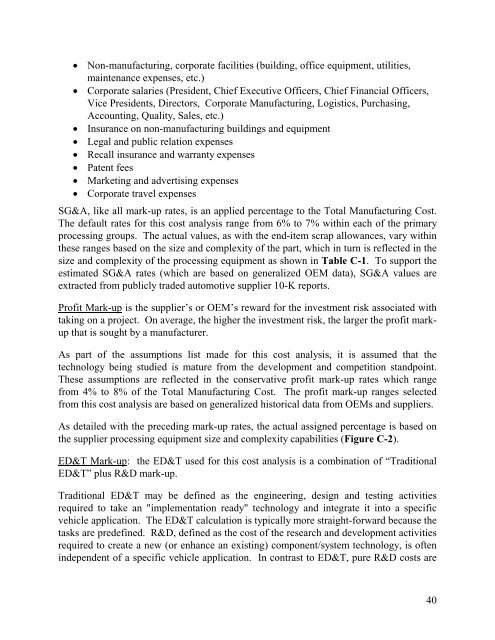Light Duty Technology Cost Analysis, Power - US Environmental ...
Light Duty Technology Cost Analysis, Power - US Environmental ...
Light Duty Technology Cost Analysis, Power - US Environmental ...
You also want an ePaper? Increase the reach of your titles
YUMPU automatically turns print PDFs into web optimized ePapers that Google loves.
� Non-manufacturing, corporate facilities (building, office equipment, utilities,<br />
maintenance expenses, etc.)<br />
� Corporate salaries (President, Chief Executive Officers, Chief Financial Officers,<br />
Vice Presidents, Directors, Corporate Manufacturing, Logistics, Purchasing,<br />
Accounting, Quality, Sales, etc.)<br />
� Insurance on non-manufacturing buildings and equipment<br />
� Legal and public relation expenses<br />
� Recall insurance and warranty expenses<br />
� Patent fees<br />
� Marketing and advertising expenses<br />
� Corporate travel expenses<br />
SG&A, like all mark-up rates, is an applied percentage to the Total Manufacturing <strong>Cost</strong>.<br />
The default rates for this cost analysis range from 6% to 7% within each of the primary<br />
processing groups. The actual values, as with the end-item scrap allowances, vary within<br />
these ranges based on the size and complexity of the part, which in turn is reflected in the<br />
size and complexity of the processing equipment as shown in Table C-1. To support the<br />
estimated SG&A rates (which are based on generalized OEM data), SG&A values are<br />
extracted from publicly traded automotive supplier 10-K reports.<br />
Profit Mark-up is the supplier’s or OEM’s reward for the investment risk associated with<br />
taking on a project. On average, the higher the investment risk, the larger the profit markup<br />
that is sought by a manufacturer.<br />
As part of the assumptions list made for this cost analysis, it is assumed that the<br />
technology being studied is mature from the development and competition standpoint.<br />
These assumptions are reflected in the conservative profit mark-up rates which range<br />
from 4% to 8% of the Total Manufacturing <strong>Cost</strong>. The profit mark-up ranges selected<br />
from this cost analysis are based on generalized historical data from OEMs and suppliers.<br />
As detailed with the preceding mark-up rates, the actual assigned percentage is based on<br />
the supplier processing equipment size and complexity capabilities (Figure C-2).<br />
ED&T Mark-up: the ED&T used for this cost analysis is a combination of “Traditional<br />
ED&T” plus R&D mark-up.<br />
Traditional ED&T may be defined as the engineering, design and testing activities<br />
required to take an "implementation ready" technology and integrate it into a specific<br />
vehicle application. The ED&T calculation is typically more straight-forward because the<br />
tasks are predefined. R&D, defined as the cost of the research and development activities<br />
required to create a new (or enhance an existing) component/system technology, is often<br />
independent of a specific vehicle application. In contrast to ED&T, pure R&D costs are<br />
40

















